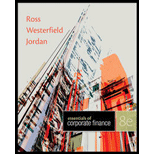
Concept explainers
What are the relevant cash flows for valuing a share of common stock?
To discuss: The relevant cash flows to value a share of common stock.
Introduction:
The common stock is a security in which the shareholder (investor) invests their money in the corporation as equity. The valuation of a share of common stock is very difficult to interpret. It is because the common stock dividends are not easy to estimate while comparing with the principal payment on a bond of preferred stock and interest.
Explanation of Solution
The expected future dividends are the most significant cash flows for valuing the share of common stock. It is because the cash flows received during the life of the stock are only the regular dividends.
The present value of stock prices is equivalent towards the present value of the future dividends of a particular company. The corporation pays these expected dividends to their respective shareholders. Therefore, dividend is considered as the relevant cash flow to determine the value of share.
The dividend paid by the company is the most important cash flow for valuing the stocks. This dividend distributed by the company is the cash flow expected only during the life of the stock.
Want to see more full solutions like this?
Chapter 7 Solutions
Essentials of Corporate Finance
 College Accounting, Chapters 1-27AccountingISBN:9781337794756Author:HEINTZ, James A.Publisher:Cengage Learning,Century 21 Accounting Multicolumn JournalAccountingISBN:9781337679503Author:GilbertsonPublisher:Cengage
College Accounting, Chapters 1-27AccountingISBN:9781337794756Author:HEINTZ, James A.Publisher:Cengage Learning,Century 21 Accounting Multicolumn JournalAccountingISBN:9781337679503Author:GilbertsonPublisher:Cengage- Principles of Accounting Volume 1AccountingISBN:9781947172685Author:OpenStaxPublisher:OpenStax College





